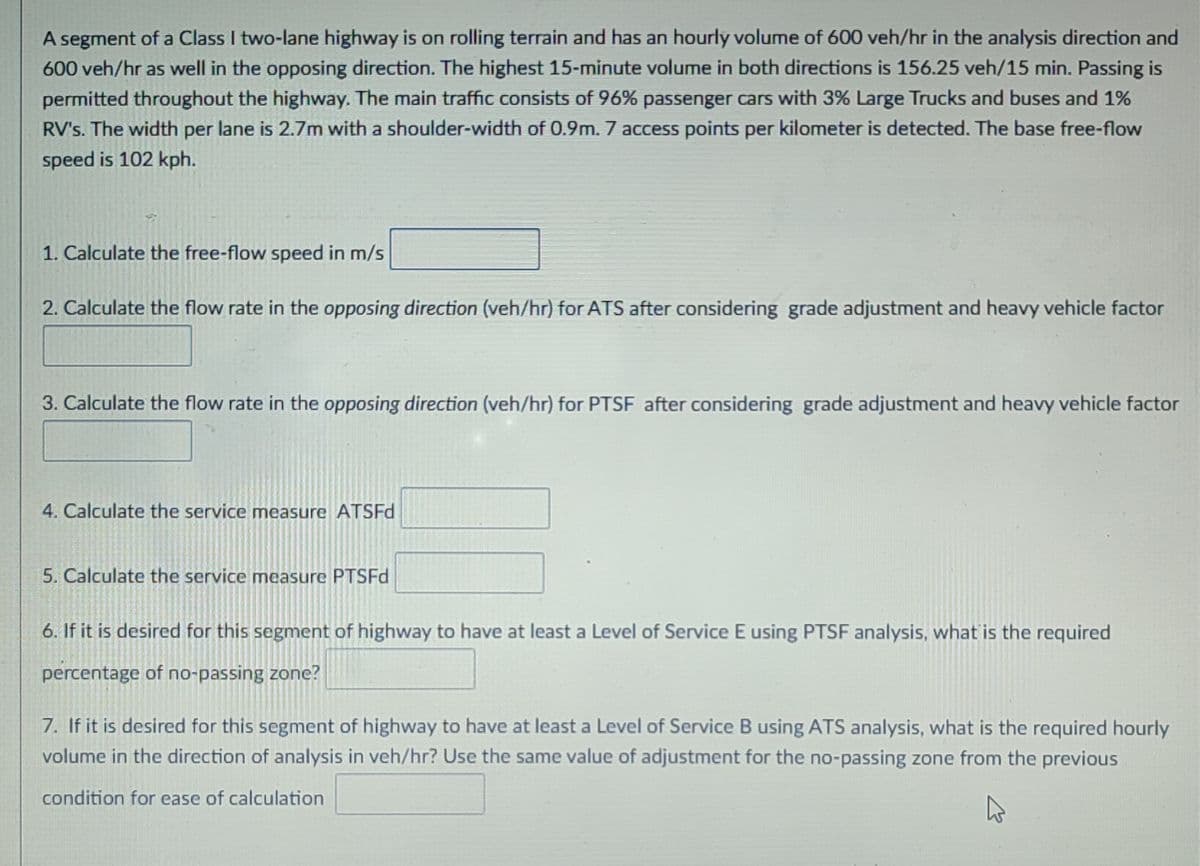A segment of a Class I two-lane highway is on rolling terrain and has an hourly volume of 600 veh/hr in the analysis direction and 600 veh/hr as well in the opposing direction. The highest 15-minute volume in both directions is 156.25 veh/15 min. Passing is permitted throughout the highway. The main traffic consists of 96% passenger cars with 3% Large Trucks and buses and 1% RV's. The width per lane is 2.7m with a shoulder-width of 0.9m. 7 access points per kilometer is detected. The base free-flow speed is 102 kph. 1. Calculate the free-flow speed in m/s 2. Calculate the flow rate in the opposing direction (veh/hr) for ATS after considering grade adjustment and heavy vehicle factor 3. Calculate the flow rate in the opposing direction (veh/hr) for PTSF after considering grade adjustment and heavy vehicle factor 4. Calculate the service measure ATSFd 5. Calculate the service measure PTSFD 6. If it is desired for this segment of highway to have at least a Level of Service E using PTSF analysis, what is the required percentage of no-passing zone? 7. If it is desired for this segment of highway to have at least a Level of Service B using ATS analysis, what is the required hourly volume in the direction of analysis in veh/hr? Use the same value of adjustment for the no-passing zone from the previous condition for ease of calculation
A segment of a Class I two-lane highway is on rolling terrain and has an hourly volume of 600 veh/hr in the analysis direction and 600 veh/hr as well in the opposing direction. The highest 15-minute volume in both directions is 156.25 veh/15 min. Passing is permitted throughout the highway. The main traffic consists of 96% passenger cars with 3% Large Trucks and buses and 1% RV's. The width per lane is 2.7m with a shoulder-width of 0.9m. 7 access points per kilometer is detected. The base free-flow speed is 102 kph. 1. Calculate the free-flow speed in m/s 2. Calculate the flow rate in the opposing direction (veh/hr) for ATS after considering grade adjustment and heavy vehicle factor 3. Calculate the flow rate in the opposing direction (veh/hr) for PTSF after considering grade adjustment and heavy vehicle factor 4. Calculate the service measure ATSFd 5. Calculate the service measure PTSFD 6. If it is desired for this segment of highway to have at least a Level of Service E using PTSF analysis, what is the required percentage of no-passing zone? 7. If it is desired for this segment of highway to have at least a Level of Service B using ATS analysis, what is the required hourly volume in the direction of analysis in veh/hr? Use the same value of adjustment for the no-passing zone from the previous condition for ease of calculation
Traffic and Highway Engineering
5th Edition
ISBN:9781305156241
Author:Garber, Nicholas J.
Publisher:Garber, Nicholas J.
Chapter9: Capacity And Level Of Service For Highway Segments
Section: Chapter Questions
Problem 21P
Related questions
Question

Transcribed Image Text:A segment of a Class I two-lane highway is on rolling terrain and has an hourly volume of 600 veh/hr in the analysis direction and
600 veh/hr as well in the opposing direction. The highest 15-minute volume in both directions is 156.25 veh/15 min. Passing is
permitted throughout the highway. The main traffic consists of 96% passenger cars with 3% Large Trucks and buses and 1%
RV's. The width per lane is 2.7m with a shoulder-width of 0.9m. 7 access points per kilometer is detected. The base free-flow
speed is 102 kph.
1. Calculate the free-flow speed in m/s
2. Calculate the flow rate in the opposing direction (veh/hr) for ATS after considering grade adjustment and heavy vehicle factor
3. Calculate the flow rate in the opposing direction (veh/hr) for PTSF after considering grade adjustment and heavy vehicle factor
4. Calculate the service measure ATSFd
5. Calculate the service measure PTSFd
6. If it is desired for this segment of highway to have at least a Level of Service E using PTSF analysis, what is the required
percentage of no-passing zone?
7. If it is desired for this segment of highway to have at least a Level of Service B using ATS analysis, what is the required hourly
volume in the direction of analysis in veh/hr? Use the same value of adjustment for the no-passing zone from the previous
condition for ease of calculation
Expert Solution
This question has been solved!
Explore an expertly crafted, step-by-step solution for a thorough understanding of key concepts.
This is a popular solution!
Trending now
This is a popular solution!
Step by step
Solved in 3 steps with 3 images

Knowledge Booster
Learn more about
Need a deep-dive on the concept behind this application? Look no further. Learn more about this topic, civil-engineering and related others by exploring similar questions and additional content below.Recommended textbooks for you

Traffic and Highway Engineering
Civil Engineering
ISBN:
9781305156241
Author:
Garber, Nicholas J.
Publisher:
Cengage Learning

Traffic and Highway Engineering
Civil Engineering
ISBN:
9781305156241
Author:
Garber, Nicholas J.
Publisher:
Cengage Learning